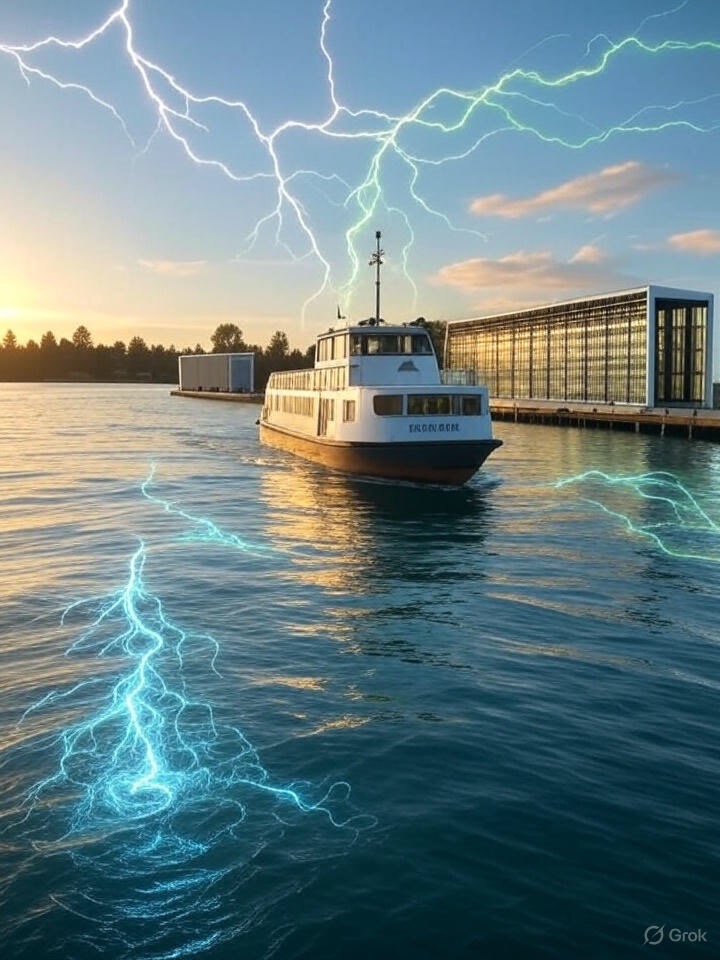Did you Know that a Downtown Battery Storage Facility is planned at the Guemes Ferry Landing? As Anacortes pushes toward sustainability with plans for an all-electric Guemes Island Ferry, the proposal to build a battery energy storage system (BESS) raises serious concerns. Recent incidents* involving BESS facilities, combined with Skagit County Commissioners recent approval of a BESS near the Port of Skagit highlight significant risks that make downtown Anacortes a questionable location. This article examines some these risks and explores possible tax implications for the community.
Risks of Battery Storage Facilities:
Lithium-ion battery storage systems, critical for powering electric ferries pose unique risks, as evidenced by global incidents.
- Lithium-ion Battery Fires and Thermal Runaway. Lithium-ion batteries can experience thermal runaway, where overheating leads to fires or explosions that are difficult to extinguish023. Examples: 2023 Otay Mesa, California, BESS facility fire and 2021 Arizona BESS facility explosion.
- Toxic Gas Emissions and Environmental Impact. Battery fires release hazardous gases like hydrogen fluoride and carbon monoxide, posing risks to residents and first responders.
- Regulatory and Oversight Gaps. BESS regulations are evolving with no comprehensive federal standards in the U.S.
- Inadequate Firefighting Capabilities. Local Fire Departments including Anacortes may lack the specialized equipment and training needed for lithium-ion fires, which require massive water volumes or specialized foam.
Potential Tax Implications:
- County taxes: Skagit County is funding the Guemes Ferry Project including the land to build the BESS storage system. However a major part of the funding is from WA State grants. Should the grant monies dry up, the gap costs and ongoing maintenance might require a sales tax increase, a further hike in ferry fares, and levies for insurance policy.
- Local Property Taxes: To fund the specialized firefighter training and specialized equipment needed for lithium-ion battery fires which City of Anacortes might be required to obtain, could lead to a special property tax levy for Anacortes citizens.
Conclusions:
The proposal for a battery storage system in downtown Anacortes at the Guemes Ferry Landing presents a complex balance of advancing sustainable energy goals and addressing significant safety and financial concerns. The risks of lithium-ion battery fires, toxic emissions, and the challenges of firefighting readiness raise important questions about the suitability of this location. Additionally, potential tax implications could impact the community, depending on funding outcomes and the need for specialized resources. While the push for an all-electric Guemes Island Ferry aligns with environmental priorities, the unique challenges of a BESS in a downtown setting deserve careful consideration. Ultimately, the decision rests on weighing these factors against the community’s values and priorities, inviting thoughtful reflection on what is best for Anacortes.

Anthony Lee
Anacortes, WA
*High profile BESS incidents in the past 5 years in the US: 2021 Surprise, Arizona: 2.16 MWh (Arizona Public Service facility explosion and fire, injuring eight firefighters). 2021 and 2022 Phase I and Phase II Moss Landing, California (730MWh). 2023 Otay Mesa, California: 250 MWh (Gateway Energy Storage Facility fire, lasting nearly two weeks). 2023 Escondido, California BESS fire. 2025 Moss Landing, California: Approximately 300 MWh (Vistra facility fire on January 16, affecting a 300 MW array, with evacuation of 1,200 residents).
